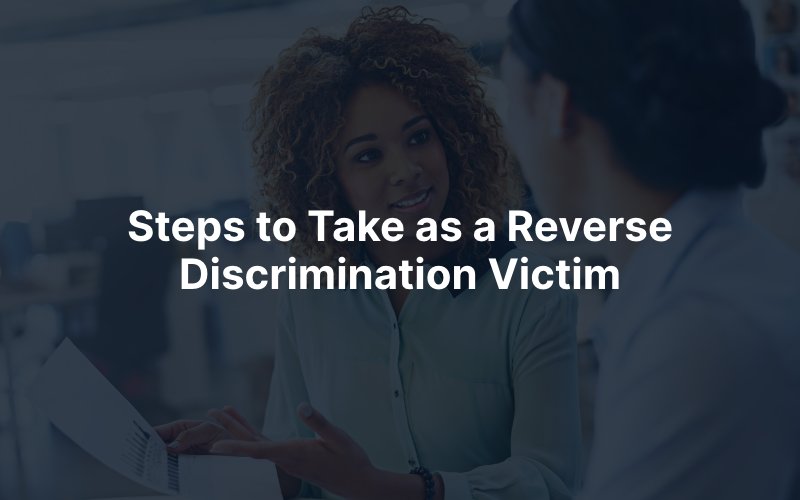If you think you are a victim of reverse discrimination, it is critical to take specific steps to protect your rights and seek justice. Here is a guide on what to do.

Gather and document all relevant information and evidence related to the discriminatory act. This may include:
Your documentation will help build a solid foundation for any future complaint, investigation, or legal action.
Most companies have policies on discrimination, equal opportunity, and workplace diversity, and also outline procedures for complaints. Check that the alleged discriminatory behavior violates company policies or falls under legally protected categories, such as race, age, gender, or national origin. This will help you understand how to file a complaint internally and the standards your employer has set.
Review your employer’s policies, as most have procedures in place for reporting discrimination. Typically, you will first report your concerns to your supervisor or human resources department. Provide them with all your documentation and a clear explanation of your situation. If your initial report does not lead to a satisfactory resolution, consider filing a formal complaint following your company’s procedures.
Identifying coworkers or supervisors who potentially witnessed the reverse discrimination and can support your claim will significantly strengthen your case. When speaking with witnesses:
Witness statements can provide valuable corroboration, helping to establish patterns of discriminatory behavior.
If your company does not take your complaint seriously or resolve the issue, consult a trusted Orange County Reverse Discrimination Lawyer. An attorney can provide you with legal advice, help you understand your rights, and guide you through the process of pursuing a legal claim. They can also assess the strength of your case and advise on the best course of action.
Evaluating Your Case
An attorney will assess the strength of your claims and determine whether your case meets the legal standard for reverse discrimination.
Guiding You Through Internal Complaints
If you need help filing an internal complaint, your attorney can provide guidance to ensure your report is comprehensive.
Representing You in Mediation
Many companies prefer to resolve reverse discrimination claims through mediation or settlement. Your attorney will negotiate on your behalf and represent your interests.
Filing Legal Claims
If internal complaints do not lead to a resolution, your attorney can file a formal complaint with a government agency or pursue legal action in court.
Hiring legal counsel early in the process significantly increases your chances of successfully holding your employer accountable.
Your lawyer may advise you that the next step is to file a charge with California’s Civil Rights Department (CRD) or the federal Equal Employment Opportunity Commission (EEOC). They can advise you on which agency to file with and here is how:
CRD
The CRD protects California employees from unlawful discrimination in the workplace. There are three options for filing a complaint:
2218 Kausen Drive, Suite 100
Elk Grove, CA 95758
Deaf, hard of hearing: 1-800-700-2320 (TTY)
EEOC
The other option is to file a charge with the EEOC, which is the agency that enforces federal laws prohibiting employment discrimination. It can be filed:
The CRD often works in conjunction with the EEOC. Either agency will investigate your complaint and may mediate a resolution or file a lawsuit on your behalf.
Mediation or settlement negotiations resolve many discrimination claims. During these discussions, both parties attempt to reach an agreement without going to court. The best possible outcome will include:
Mediation offers a faster, less adversarial way to resolve disputes, but legal representation is essential to protect your interests.
If the CRD or EEOC determines that your claim has merit and mediation efforts fail, they may issue you a “Right-To-Sue” notice giving you the option to file a lawsuit. Your attorney can help you navigate this process, which may involve:
Reverse discrimination occurs when policies or practices designed to promote diversity or rectify historical injustices result in unfair treatment of individuals from historically privileged groups. For example:
Hiring Practices
A company has an affirmative action policy that mandates hiring a certain percentage of employees from underrepresented groups. A more qualified candidate who is a majority member is rejected in favor of a less qualified candidate from a minority group solely to meet these quotas.
Promotion Decisions
A highly qualified and experienced male employee is passed over for a promotion in favor of a less qualified female candidate.
Training and Development Opportunities
An organization offers specialized training and development programs exclusively to minority employees to promote diversity in leadership roles. Employees who are members of a majority are excluded from these opportunities despite their interest and qualifications.
Performance Evaluations
A manager consistently gives higher performance ratings to minority employees than to their non-minority counterparts despite the latter’s similar or superior performance.
Salary Increases and Bonuses
A company implements a policy to address pay disparities by giving larger raises and bonuses to minority employees compared to their non-minority colleagues with similar job roles and performance levels. While intended to rectify historical pay inequities, such policies can be seen as reverse discrimination if they do not equally reward performance and qualifications.
Fostering an inclusive workplace culture that values diversity while maintaining fairness is a delicate balance. Employers must create environments where all employees feel valued and respected, regardless of their background.
Here are the common types of compensation that might be awarded in a reverse discrimination claim:
The court may also order injunctive relief, requiring the employer to take specific actions to rectify the discriminatory practices. This may include policy changes, training programs, and more.